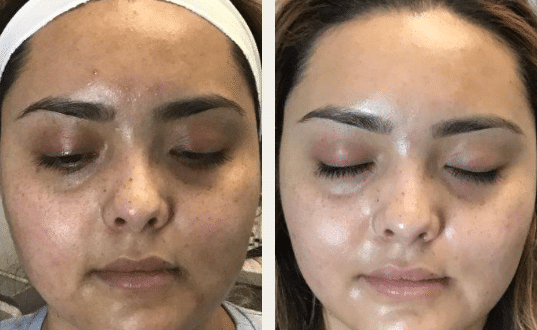What Types of Microneedling are Available?
With so many skin rejuvenation options, how do you decide which one will work best for you? Microneedling is an effective way to treat a wide range of skin issues with minimal downtime and long-lasting results. Also known as collagen induction therapy, microneedling can address concerns from pigmentation problems to lines, wrinkles, and acne scars.
What is Microneedling (Collagen Induction Therapy)?
With all the lasers and other facial treatments available, microneedling remains one of the most popular methods of skin rejuvenation. Dr. Freda Cobbinah and her team at Essential Med Clinic & Aesthetics are experienced microneedling providers who can ensure you see the best possible results.
Microneedling is also known as collagen induction therapy due to its ability to stimulate new collagen and elastin formation. These proteins form the vital support structure of your skin, giving it elasticity and resilience. They begin to decline as you age, but microneedling effectively restores youthful levels of collagen production for firmer, smoother skin. It also triggers cellular renewal to replace dull, damaged skin cells with healthy, vibrant ones.
*Individual Results May Vary
How Does Microneedling Work?
The outermost layer of your skin, the epidermis, is made up of tightly packed dead skin cells. While this layer plays a vital role in protecting you from the outside world, it can prevent most skin treatments from reaching the layers where they are most needed.
Microneedling works by using rows of tiny needles to create microchannels in the skin. These channels reach into the dermis, where cells called fibroblasts live. These cells produce collagen and elastin, and the controlled damage produced by the needles triggers them to increase their activity. At the same time, other skin cells respond with a flood of healing and growth factors that initiate a process of cellular renewal.
What Types of Microneedling are Available?
Dr. Cobbinah uses traditional microneedling that works using an applicator with rows of tiny needles. Due to the popularity of this treatment, several options are now available. However, all achieve the same goal of stimulating collagen formation and cell turnover.
Radiofrequency Microneedling
This type of microneedling uses needles that transmit radiofrequency (RF) energy into the dermis. This energy produces heat that helps stimulate new collagen production. However, the heat can mean that RF microneedling requires more downtime than the standard method while treating the same skin concerns.
Microneedling Pen
A microneedling pen uses a small tip instead of the larger microneedling applicator. It produces the same effects and is used to address the same concerns. Some providers find it useful for targeting smaller areas more precisely.
Microneedling With PRP
In this treatment, standard microneedling is combined with PRP (platelet-rich plasma). This treatment uses a sample of your blood, spins it in a centrifuge to extract the platelets, and applies it to your skin immediately after microneedling. The channels allow the PRP to penetrate more deeply. Some evidence indicates that PRP can speed healing, but downtime with microneedling is minimal regardless.
Most people will be pleased with their microneedling results regardless of which type is used. All are forms of collagen induction therapy and achieve very similar results.
What Does Microneedling Treat?
Microneedling can dramatically improve your skin in a variety of ways. We recommend this treatment to address concerns including:
- Fine lines and wrinkles
- Skin laxity
- Uneven skin tone
- Acne scars
- Enlarged pores
- Hyperpigmentation
- Melasma
- Sun damage
- Age spots
People have microneedling for many reasons, but the end result is skin that looks smoother, clearer, and more even.
Is There Any Downtime After Microneedling?
Depending on the intensity of your treatment, microneedling may result in a few hours to a day or two of redness, swelling, and sensitivity. These effects are usually minor and fade quickly. Your skin will require sun protection while it heals, and you should avoid harsh or irritating skin products for at least a week. We can recommend skincare products that your skin will absorb especially well after microneedling.
Request a Consultation
Simply fill out the form on this page, and we will reach out to you promptly to schedule your appointment.
How Many Microneedling Treatments Will I Need?
The number of microneedling sessions required depends on your skin concerns and unique response to the treatment. Most people will benefit from at least three to five sessions to achieve their goals. Some people may need more treatments, especially if they are treating more significant laxity and wrinkles. Each treatment triggers more collagen production for a cumulative effect.
What Results Will I See After Microneedling?
You may start to see results within a few days of treatment as healthy new skin cells are revealed. Collagen production is a more gradual process so you may see improvements in firmness and texture after a few weeks. Maximum results are achieved about three months after your last treatment.
Microneedling results can last a year or more, especially if you use consistent sun protection and quality skincare products. Many people benefit from yearly maintenance treatment to keep collagen production at high levels and skin looking firm and even. We will help you develop a schedule that keeps your results looking bright and youthful.
Can I Do Microneedling at Home?
If you have seen at-home microneedling kits for sale, you may wonder if they would be worth a try. The answer is that they are not only a waste of money but can be harmful to your skin. Reasons not to do your own microneedling include:
- The treatment is unlikely to have any positive effect
- If the needles break the skin, they can cause scars and infections
- You can make some conditions even worse
- You may use it too much and cause scarring or hyperpigmentation
- You can spread bacteria to other parts of your face
If you want to try at-home skincare options, ask us for recommendations. There are many safe, dermatologist-approved at-home treatments, but microneedling is not one of them.
Am I a Good Candidate for Microneedling?
Microneedling is safe for all skin types, even very sensitive skin. Unlike some lasers, it is also safe for all skin tones. Good candidates for microneedling have reasonable expectations and are in good health. You should not have microneedling if you have an infection, active skin condition, or injury in the treatment area. It is also not recommended for people with certain medical conditions or the tendency to form abnormal scars.
Take the Next Step
If you have further questions about microneedling, please call us at (210) 568-7555 or complete our online contact form, and one of our trusted staff members will reach out to you. Essential Med Aesthetics is located in San Antonio, Texas.







